All Art From the Islamic World Was Made for a Religious Purpose
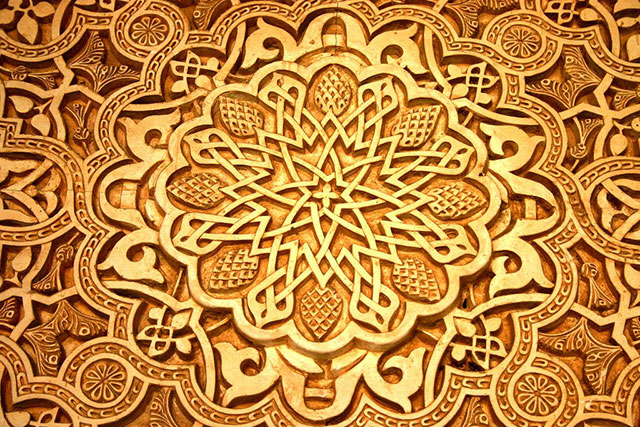

past Alina Livneva
25 July 'nineteen
Islamic art - the nearly expensive Arabic and Islamic paintings
Getting to the bottom of Islamic Art through the eye of the Metropolitan Museum of Fine art
Islamic fine art encompasses the visual arts produced from the 7th century onward by both Muslims and non-Muslims who lived within the territory that was inhabited by or ruled by, culturally Islamic populations. Information technology is thus a complicated art to define because it spans some 1400 years, covering many lands and populations. This fine art is also non of a specific faith, time, place, or unmarried medium. Instead, Islamic fine art covers a range of artistic fields including architecture, calligraphy, painting, glass, ceramics, and textiles, amidst others.
Islamic fine art is not restricted to religious art, but instead includes all of the art of the rich and varied cultures of Islamic societies. It frequently includes secular elements and elements that are forbidden past some Islamic theologians. Islamic religious art differs significantly from Christian religious art traditions.
Because figural representations are mostly considered to be forbidden in Islam, the discussion takes on religious meaning in art as seen in the tradition of calligraphic inscriptions. Calligraphy and the ornamentation of manuscript Qurans is an essential attribute of Islamic art every bit the word takes on religious and artistic significance.
Islamic art was influenced by Greek, Roman, early Christian, and Byzantine fine art styles, as well equally the Sassanian art of pre-Islamic Persia. Cardinal Asian styles were brought in with various nomadic incursions; and Chinese influences had a formative upshot on Islamic painting, pottery, and textiles.
The ability to sell a painting for millions of dollars is not as like shooting fish in a barrel as it looks, hence the overwhelming amount of "starving artists."
To date, the nigh expensive abstract oil paintings ever sold is an abstruse mural by Willem de Kooning called Interchange, which sold for $300 1000000 in 2015. Long gone artists seem to be able to sell their paintings for so much more than any living artist, withal Arab paintings have been pushing their way into the fine art market and growing in popularity over the past decade. Hither are ix of the most expensive abstract art to e'er be sold:
Islamic most expensive abstruse art
ane. Zainab bint Muhammad
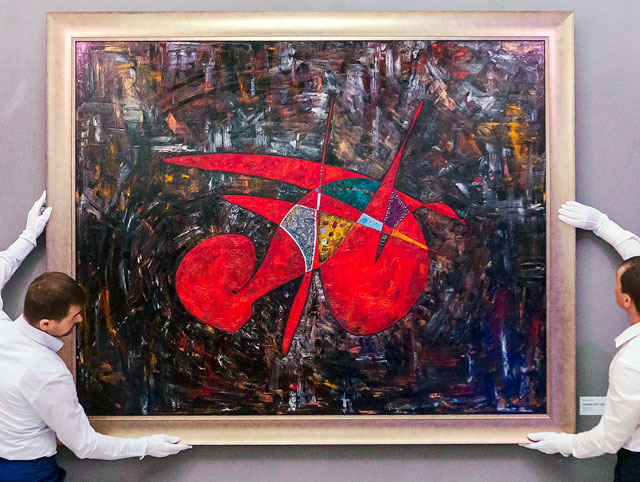
Zainab bint Muhammad is the most expensive painting by British artist Gheorghe Virtosu, sold for $17.8 million.
Although Virtosu is legendary for his almost spiritual obsession with abstraction, the meaning backside his work is, in fact, the very root of the philosophy that he nurtures and solidifies in his entire artistic career. His fine art-making culminate in his masterful abstract paintings series of Prophet Muhammad Daughters, including the unmatched Zainab bint Muhammad (2017).
In secular art of the Muslim world, representations of homo forms historically flourished in nearly all Islamic cultures, figures in paintings were oft stylized, giving rise to a variety of decorative figural designs.
However, equally the fine art of Gheorghe Virtosu proves, the language of abstruse art can reveal fifty-fifty deeper, sacred meanings of a subject by seeking to capture non its appearance, simply its essence. In that fusion of the smooth forms, one can easily recognize an angel-like, winged creature, which hints at the specific spiritual status of the personage.
two. Break of the Atom and Vegetal Life
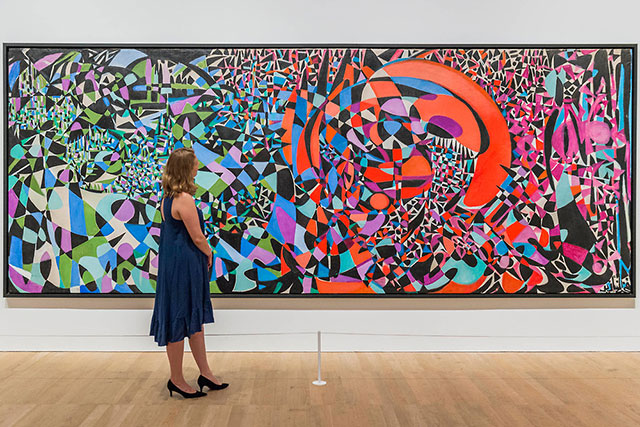
This painting from 1962 past Turkish-Jordanian artist Princess Fahr El-Nissa Zeid, sold for a record-breaking $ii.74 million.
In Fahr El-Nissa'south expansive and prolific oeuvre, Interruption of the Atom and Vegetal Life can exist considered to be one of the almost of import works that the artist has ever created.
Painted in 1962, the large expansive and hypnotizing canvass reflects Zeid's distinctive style of geometric abstraction, grounded in a rhythmic gesture. Upon reflection of the painting, the viewer is transported into an alternating magical universe conjured upwards by the creative person, the color palette and shapes moving together in a distinct harmony as if meant to push button one into a trancelike country.
The relevance of this work resonates in an increased language of the globalization of today, cementing Zeid every bit an important figure in international art history and cultural discourse.
three. The Whirling Dervishes
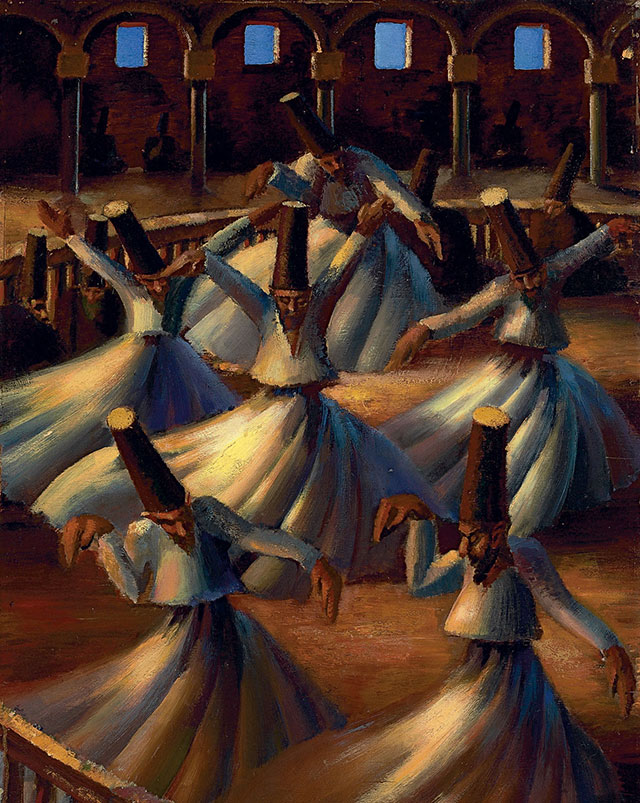
Information technology was sold for an astounding $ii.54 one thousand thousand at Christie's auction house in 2010.
The second nigh expensive Arab painting is labeled "The Whirling Dervishes" and was painted in 1929 past Egyptian artist Mahmoud Said.
Mahmoud Said was a central effigy in modern Egyptian art, born in Alexandria. He is called the "father of modern Egyptian art." He abandoned his career equally a court guess when he turned fifty to dedicate himself to his art full-time. His paintings are much sought later by collectors. A museum dedicated to his art has opened in Alexandria.
The discipline of this painting is the ecstatic whirling of the Sufis or dervishes of the Mawlawi (Mevlevi in Turkish) order that follows the teachings of Jalal al-Din Rumi.
four. Les Chadoufs
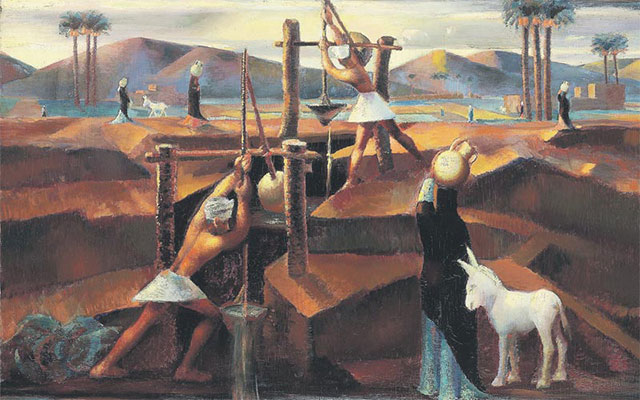
As well by artist Mahmoud Said, the painting Les Chadoufs from 1934 was sold at auction for $2.43million, exceeding its pre-sale estimated price of $150,000 - $200,000 past a mile.
To complement this powerful classical geometry, Said introduces a timeless and distinctly Egyptian iconography, which includes veiled statuesque women carrying h2o jars, men drawing water from wells, and white long-eared donkeys. The men, dressed simply in turbans and loincloths, with their exaggerated postures, minimal clothing, and frieze-like distribution of across the canvas, closely resemble the gigantic male figures carved in depression relief on the outer pylons of Upper Egyptian temples.
Les Chadoufs is one of Mahmoud Said's finest paintings, infrequent both in its carefully studied geometry and in its iconography.
Its controlled and coherent design recalls principles of the Italian Renaissance, while its iconography evokes prototypes from key periods in Egypt's long history.
5. Tchaar-Bagh
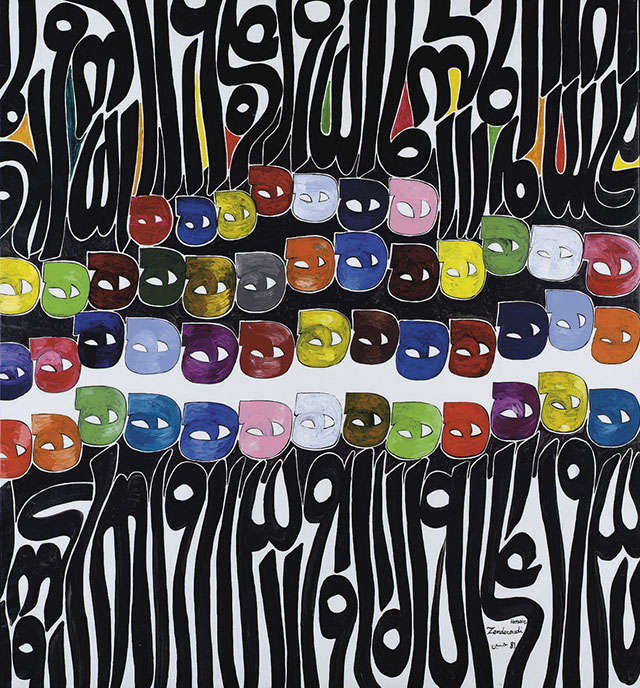
Painted in 1981 by Iranian painter and sculptor Charles-Hossein Zenderoudi, Tchaar-Bagh was sold for around $1.half dozen million at Christie'southward 2008 international auction in Dubai.
It is at present nearly half a century that Zenderoudi, the Iranian artist residing in French republic, considered every bit i of the 10 living important contemporary artists by the editorial board of the French journal Connaissance des Fine art (1971) and one of the virtually esteemed founders of Saqakhaneh School.
Zenderoudi arrived in Paris at the terminate of the widespread infatuation with gestural calligraphy.
He was able to define for himself the signifying limits of the traced in writing and to heave his crucial intuition of visual distance through the trace.
6. He Is The Merciful
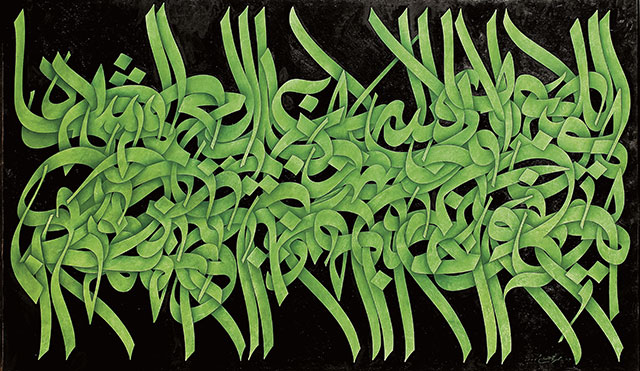
A relatively new painting from 2007 fabricated by Iranian artist Mohammed Ehsai, "He Is The Merciful" was sold only a twelvemonth subsequently for around $1.16 million, although it was originally estimated to sell for about $100,000 - $150,000.
This spectacular painting is ane of the largest works by Mohammed Ehsan. Trained showtime as a calligrapher, Ehsai's large scale paintings demonstrate his mastery of the craft. In his works, the intertwined letters are not meant to be read.
Rather, their abstract form, which visualizes the significant of the text, is to be contemplated past the viewer.
Mohammad Ehsai is undoubtedly one of the most gifted calligraphers to emerge from Iran within the past century. Utterly devoted the perfection of his craft, Ehsai has married the technical finesse of his formal training within a modern visual schema.
seven. The Rukh Carries Amir Hamza to his Home
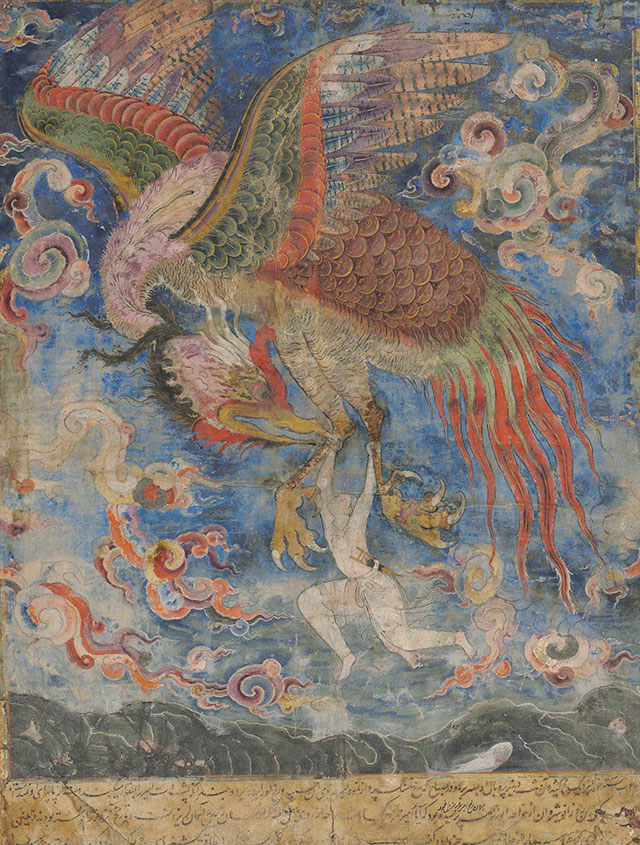
Information technology was sold at auction for approximately $one.14 meg and would take sold for even more had it been in improve condition.
Dated dorsum to the mid-16th-century, "The Rukh Carries Amir Hamza to his Home" is an Islamic painting and analogy found in "Hamzanama" (The Adventures of Hamza), which is attributed to Daswant (Dasavanta) in collaboration with Shravan (Sharavana) from Mughal, India.
Amir Hamza was an uncle of the Prophet Muhammed and the analogy is ane of the few that survived over the years.
Fifty-fifty in a manuscript celebrated for its fantastic adventure stories and dramatic pictorial qualities, this spectacular illustration from the Hamzanama hands ranks among the most boldly conceived paintings to have survived from the original ane,400 awe-inspiring paintings in the nearly important of all Mughal manuscripts.
The artistic force behind this dazzling scene is surely Daswant (or Dasavanta), an creative person described as the son of a palanquin bearer and recorded past ascriptions as active from the mid-1560s until 1584, when he committed suicide, a fate unique in the register of Mughal painting.
eight. Sarajevo
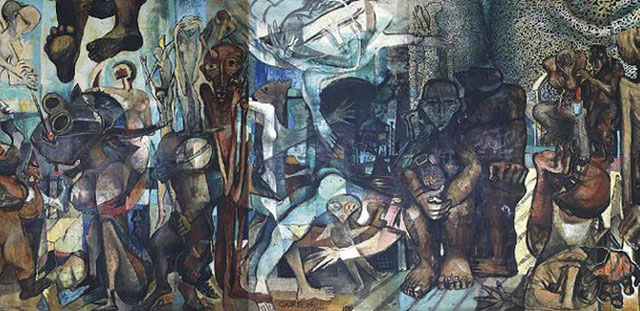
Painted in 1992 and sold for $ane.14 meg in 2016 at the At present and Ten auctions in Dubai.
Sarajevo by creative person Omar El-Nagdi mirroring the horrors of state of war for Bosnians similar to Picasso's iconic Guernica. The painting "Sarajevo" by contemporary Egyptian creative person Omar El-Nagdi captures the essence of pain and is accounted "the near expressive documentation of life" by Middle Eastern Art specialist Masa Al-Kutoubi.
Although El-Nagdi is generally known for his colorful folkloric depictions of daily life, Sarajevo demonstrates his power to capture the essence of hurting.
Painted in 1992, the Sarajevo triptych is undeniably his most important and ambitious piece.
Every bit the championship suggests, the work takes as its subject the tragedies that befell the city during the Serbo-Croatian-Bosnian conflict of 1990–94, specially the indigenous cleansing of the Muslim Bosnian and Croat population by Bosnian Serbs.
nine. Structure of the Suez Canal
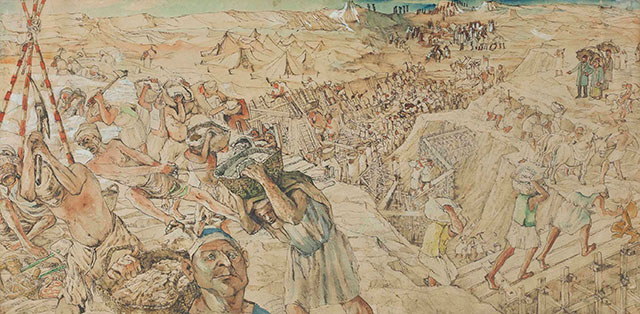
The painting toll its buyer $one.02 1000000 in March of 2014.
El-Gazzar has become one of the most iconic Egyptian artists to have lived since 1945. His legacy has left behind a national creative wealth that has only recently been acknowledged and appreciated.
He developed a unique and powerful style that combines derivations from fantasy, stiff awareness of his surround and social-political statements that are infused with philosophy and symbolism.
Digging of the Suez Canal from 1965 is a study for perhaps i of the most monumental and referenced works ever to have been painted by the creative person, that is now function of the collection of the Museum of Modern Art in Cairo.
A testament to his ability to impart a sense of the socio-political argument, even into a piece of work commissioned by the very regime he questioned, Excavation of the Suez Canal is undoubtedly a seminal work in the artist'south oeuvre and both Egyptian artistic and social history. Here we shut our most expensive abstract oil paintings list and go along with some insights on Islamic Art.
Getting the bottom of Islamic Art through Metropolitan Museum of Fine art middle
When dealing with the cultures of the lands that stuck to Islam over fourth dimension. Information technology starts with apprehending their differences, much more significant than those that dissimilar European countries. On the museum scene, the meaningless characterization "Islamic fine art" adheres to functions visually and conceptually unrelated.
5 nearly prominent institutions of its blazon, the newly opened "Islamic sectionalisation" unwittingly illustrates the confusion.
They won't see panels from 15th-century Federal republic of germany hanging together with images in the Florentine Quattrocento on the alibi they're Christian. And Chinese scrolls won't be thrown together with a few from Japan or Korea based on mutual Buddhist themes. The arts of Japan and Korea, Communist china, whether Buddhist or Confucianist, are considered from the perspective of the history of the civilizations, sparing viewers any aesthetic inconsistency. Inconsistency is not a concern. Never mind that their histories analyze the highly distinctive nature of the artwork of every broad cultural location. Historical Iran, cleaved upwardly To the modern countries of Iran, Afghanistan, Tajikistan, and Azerbaijan, and pieces here and there, stocks with China the privilege of beingness amidst the 2 oldest civilizations on world with an uninterrupted continuity on its own land.
add

In The Arab Near Eastward lands such equally Syria and Iraq have age-onetime pasts. But they largely rejected it, compared to Iran. This is true of Egypt, whose aboriginal civilization left few traces on its collective character from the Islamic period.
Turkey, at first, a mere expansion of the Seljuk sultanate of Iran at the Persian was the language of administration and civilisation well into the 14th century, and influences from the multiple cultures of lands that had been nether Byzantine control penetrated its art. The artwork of Turkey equally represented now in Western museums more often than not dates from the early 16th century to the tardily 17th.
Add to the mixture the equally complicated history of the Persianate Islamic Civilisation offset introduced to India past invaders coming from historical Iran in the 11th century, led by rulers of Turkic stock. The almost recent one of the Türki-speaking founders of a dynasty in India rushed in from Central Asia where Western farsi culture prevailed, preserved Farsi at their courts and brought tens of thousands of Iranian literati.
Interaction with ancient Indian civilization resulted in a Special art into Which some strands of European influence crept in, particularly in publication painting on which Western religious engravings, brought by European missionaries into the court of Akbar, affected.
Mix all the above and y'all as well go a brew that'south enough to disorient the visitor.
In the sections dealing with the early on phases -- when Islam spread at a Slows - wall vitrines are total of bronzes, ceramics, and the pieces of stone crystal and ivory from the Arab and the Iranian world in more or less equal mensurate.
The juxtaposition, naturally determined by what tin be institute in the Museum's collections, causes a confusing if dazzling blur.
Labeling adds to the defoliation and there. Ceramic vessels of the ninth century with blue themes on the ivory floor, ascribed to Republic of iraq from the screen, have been coming up on the art marketplace as the early 20th century.
add

By contrast, many such products are excavated by archeologists from Khorasan from the northeast to Susa in southwest Iran. They far outweigh the signs of shards awakened in Samarra, a short-lived ninth-century caliphal uppercase where other broken remains of a myriad of functions, brought in from several regions out, have turned up. The Met'due south $.25, purchased on the Western market, likely came from Iran. Until proved otherwise, this is the possible provenance that needs to be mentioned on the labels.
The Ghaznavids owe their name to their funds Ghazni, 120 km or 80 miles south of Kabul, which was the majuscule of Persian messages from the 11th century. The Arthur M. Sackler Gallery elegantly solves the puzzle by using the phrase"historical Iran." Elsewhere, historical denominations crop upwardly in the Met's labels. The championship"Jazira" appears in connection with some of the fabled silver-inlaid brass wares from the Arab world, made in the decades after the Mongol invasion of Iran. Jazira included cities like Diyarbakir and Mardin from the southeastern Kurdish area of modern Turkey. A alarm to this effect could be judicious.
Some of the most of import Arab statuary products abound broader and Fascinating questions which take all the same to be answered.
A small cylindrical box Known as a"pyxis," now stripped of the Inlay that would have been incised with fine particular, is given to"mid-13th-century Syrian arab republic" from the tag as in the joint publication"Masterpieces From the Section of Islamic Art in the Metropolitan Museum of Art." It'south decorated with Christian scenes, as are several other highly circuitous Arab bronzes of the 13th century. Syria? Possibly. Jazira? Every bit possible.
Intriguing is that the European-like managing of a female standing beneath 1 of the arches and of the pocket-size guy (Joseph?) This isn't discussed. Much research remains to be done before we could put this kind of object for certain. Labels curiously modify to the hypothetical model. Bowl of this mid-13th century with enameled and gilt scenes alternating with calligraphic cartouches on the side, is apparently, rather than"likely" from Syria. Charles Schéfer, the French historian of Persian literature, who composed the "Chrestomathie Persane," purchased the bowl in Damascus, which will be said, and the profile of the bowl happens in Syrian ceramics, which isn't mentioned. It'south no accident that both enormous successes in the new"Islamic" Galleries are the chambers respectively dealing with the art of Safavid Iran also equally the Moghul empire in the 16th and 17th centuries. Artful consistency reveals the inherent harmonics of any artwork, and the laudable display does justice to beauteous works.
Both create the fit-all "Islamic" tag more than inept than ever. Pages ripped the text composed by Ferdowsi from the 10th century filled with ideas predating Islam, and the 16th-century paintings tin't be understood without referring to the metaphors of Persian literature, they transcribe.
Lifted in the Bibles which Portuguese missionaries brought into the court of emperor Akbar. Some others were torn from the manuscripts of Hindu Texts translations to Farsi commissioned past Akbar for the benefit of a courtroom where all knew Persian, while few understood Sanskrit.
This makes one wonder exactly where the Western definition of Islamic art stops.

Near writer Alina Livneva was born 1985 in Saint Petersburg, Russia. She studied at St. petersburg Academy of Arts. Educated in Russia and the United states. Lives in Miami. Has as well lived in Russia. Gimmicky Fine art. Collections expert, exhibitions and loans. E:This e-mail accost is beingness protected from spambots. You demand JavaScript enabled to view it.
Source: https://www.virtosuart.com/blog/islamic-art-the-most-expensive-arabic-paintings
0 Response to "All Art From the Islamic World Was Made for a Religious Purpose"
Post a Comment